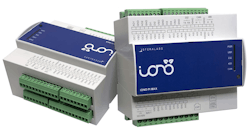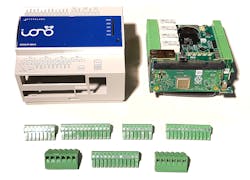Put Raspberry Pi in Control of the Production Line
This article is part of TechXchange: Raspberry Pi
Also check out our video Examining Sfera Labs' Iono Pi Max.
What you’ll learn
- How to take advantage of the Raspberry Pi in process control environments.
- What functionality is provided by the Iono Pi Max?
Programmable logic controllers (PLCs) are ubiquitous in the process control space, managing everything from assembly lines to chemical plants. PLCs can be very simple, but more complex systems require more intelligent logic. The plethora of sensors available to designers and the addition of machine learning (ML) is placing heavier demands on PLCs.
Most PLCs are proprietary, closed hardware solutions with a range of programming options from simple ladder logic to fully programmable software platforms. There’s also a trend toward open-source hardware that takes advantage of popular platforms like the Raspberry Pi. It’s possible to design a system from scratch using a Raspberry Pi via modules. However, most engineers would rather use an off-the-shelf solution like Sfera Labs’ Iono Pi Max (see figure).
The Iono Pi Max is built around a Raspberry Pi Compute Module 3+ (CM3+). The DIN rail case PLC includes a carrier board for the CM3+ and a two-board stack that contains interface logic and removable terminal block connectors. It’s designed to handle a wide range of digital and analog inputs and outputs, including four NO/NC relays rated at 6 A at 250 V, two temperature sensor ports, as well as RS-232, RS-485, and CAN V2.0B interfaces. The system also has a 10/100 BASE-T Ethernet port and three USB 2.0 ports, one of which is internal.
With this module approach, users can select any CM3+ configurations that include up to 32 GB of storage. In addition, there’s a Microchip ATSAME54 Cortex-M4, 32-bit microcontroller in the mix for real-time support. It has 1 MB of program memory and 256 kB of RAM.
The system also features dual SD card slots, a real-time clock, watchdog timer, and Microchip’s ATECC608A secure element for secure IoT support. It has a 3.3-A resettable fuse—power can range from 10 to 50 V dc. The UPS port works with 12- or 24-V batteries. Furthermore, there’s a 12- to 24-V dc software-controlled output.
These days, it’s not uncommon for development to start on a platform like Raspberry Pi. The trick is turning it into a production unit. The Iono Pi Max makes this happen for rugged, industrial control solutions. The platform can be delivered with Linux installed and it includes frameworks like SocketCAN. The system is able to run machine-learning models as well as Docker containers.


